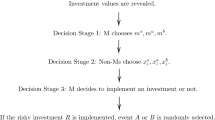Abstract
Takeover and acquisition of corporations is awell-researched area and has been becomingincreasingly important. Much less research emphasishas been devoted to takeover activity within thegeneral area of financial services with thisparticularly the case for the building society sector.
The building societies being mutual companies havespecial characteristics. The building societies andother financial mutuals like the corporations doencounter an acute agency problem. This opens up apotential application of Grossman and Hart theory oftakeovers bids as the individuals have option to freeride, securing knowledge that the regulatory processrenders their deposits de facto risk-free investment.This free-rider problem, like the corporations can beovercome by inducing hostile takeover.
Some empirical studies of mergers activities withinthe building society sector have dealt with onlyintra-sectoral mergers. However, they have not lookedat inter-sectoral mergers and have not addressedefficiency issues in a general equilibrium frameworkusing game theory.
In this paper I suggest a mechanism for merger at parwith sales of stocks of a corporation to organisebuilding societies' takeovers. I develop a two-stagegame between the members of building societies and theraider. Analysis of non-cooperative voting behaviourof members of Cheltenham and Gloucester buildingsociety shows that the actions of the members of thebuilding society may also give rise to less thanoptimal results as they may not be acting in their bestinterests. The members of the building society cangain if a hostile takeover is induced rather than afriendly takeover. The paper also examines the freerider problem and ex-ante efficiency in a generalequilibrium framework.
Similar content being viewed by others
References
Aumann, R. J.: 1987, "Game Theory", in John Eatwell, Murray Milgate and Peter Newmann (eds.), The New Palgrave: A Dictionary of Economics (New York: The McMillan Press Ltd.).
Bagnoli, Mark and Bart Lipman: 1988, "Successful Takeovers Without Exclusion", The Review of Financial Studies 1(1): 89–110.
Baumol, J.: 1959, Business Behaviour Value and Growth (New York: McMillan).
Barnes, P. and J. C. Dodds: 1981, "Building Societies Mergers and the Size-Efficiency Relationship-a Comment", Applied Economics 13(4): 531–534.
Barnes, P.: 1985, "UK Building Societies-a Study of the Gains from Merger",Journal of Business Finance and Accounting 12(1): 75–92.
Barnes, P.: 1998, "Why do Bidders do Bbadly Out of Mergers Some UK Evidence", Journal of Business Finance and Accounting (June/July) 25(5&6).
Bradley, M. and E. H. Kim: 1985, "The Tender Offer as a Takeover Device: Its Evolution, the Free-Rider Problem, and the Prisoner's Dilemma", in S. Deman (ed.), Forthcoming in the Advances in the Theory of Corporate Takeover Bids: Game-Theoretic Models and Econometric Estimation.
Caves, R. E.: 1989, "Mergers, Takeovers and Economic Efficiency: Foresight versus Hindsight", International Journal of Industrial Organisation 7: 73–100.
Coase, R. H.: 1960, "The Problem of Social Cost", Journal of Law Economics 3: 1–44.
Davies, G. and M. Davies: 1981, Building Societies and their Branches-Regional Economic Survey (London: Francy & Co.).
Deman, S.: 1997, "Game Theory in Finance", in Dean Paxton and DoughWood (eds.), The Blackwell Encyclopedia Dictionary of Finance (Blackwell).
Deman, S.: 1997, "Corporate Takeovers Language", in Dean Paxton and Dough Wood (eds.), The Blackwell Encyclopedia Dictionary of Finance (Blackwell).
Deman, S.: 1996, "Merger Mania and C. G.", Management Research News 19(1/2): 45–52.
Deman, S.: 1994, "The Theory of Corporate Takeover Bids: A Subgame Perfect Approach", Managerial and Decision Economics 15: 383–397.
Deman, S. and K. W. Wen: 1994, "The Theory of Real Estate Takeover: A Subgame Perfect Approach", Advances in Econometrics 10: 65–82.
Deman, S.: 1991, "The Theory of Takeover Bid: A Game-theoretic Model", Advances in Econometrics 9: 139–155.
Deman, S.: 1989, "The Theory of Corporate Takeover Bids: A Review", Working Paper, Australian National University.
Gough, T. J.: 1995, The Economics of Building Societies (London: McMillan Co.).
Gough, T. J.: 1979, "Building Society Mergers and the Size-Efficiency Relationship-A Reply", Applied Economics 13(4): 535–538.
Gough, T. J.: 1979, "Building Society Mergers and the Size-Efficiency Relationship", Applied Economics 11(1): 185–194.
Grossman, S. and O. Hart: 1980a, "Takeover Bids, the Free-rider Problem, and the Theory of the Corporation", Bell Journal of Economics 11: 42–64.
Hartwick, J., U. Schweizer and P. Varaiya: 1976, "Comparative Statics of a Residential Economy with Several Classes", Journal of Economic Theory 13: 396–413.
Hirshleifer, D. and S. Titman: 1990, "Share Tendering Strategies and the Success of Hostile Takeover Bids", Journal of Political Economy 98: 295–324.
Holmstrom, B. and B. Nalebuff: 1992, "To the Raider Goes the Surplus? A Reexamination of the Free-Rider Problem", Journal of Economics and Management Studies.
Kreps, D.: 1990, A Course in Microeconomic Theory (Princeton: Princeton University Press).
Leibenstein, H.: 1976, Beyond Economic Man: A New Foundation for Microeconomics (Harward Press).
Manne, H. G.: 1965, "Mergers and the Market for Corporate Control", The Journal of Political Economy 73: 110–120.
Markey, Andrew: 1994, Modelling a Building Society Takeover: A Game-Theoretic Approach.Master Thesis Under the Supervision of S. Deman.
Marris, R.: 1964, The Economic Theory of Managerial Capitalism (London: McMillan).
Milgrom and Roberts: 1982, "Limit Pricing and Entry Under Incomplete Information: An Equilibrium Analysis", Econometrica 50: 443–459.
Myerson, R. and M. Satterthwaite: 1983, "Efficient Mechanisms for Bilateral Trading",Journal of Economic Theory 29: 265–281.
Rasmussen, E.: 1992, "Games Theory in Finance", in Pater Newmann, John Milgate and Murray Eatwell (eds.), The New Palgrave of Money and Finance (New York: The McMillan Limited).
Shleifer, Andrei and Robert W. Vishny: 1986, "Large Shareholders and Corporate Control", Journal of Political Economy 94: 461–488.
Thompson, Steve: 1997, "Takeover Activity Among Financial Mutuals: An analysis of Target Characteristics", Journal of Banking and Finance 21: 37–53.
Thompson, Steve: 1996, "Merger Without Equity Markets: A Study of the Acquisitions Process Among Financial Mutuals", Journal of Institutional Economics 152(2): 342–359.
Von Neumann, J. and O. Morgenstern: 1947, The Theory of Games and Economic Behaviour, 2nd edn. (New York: Wiley).
Williamson, O. E.: 1974, The Economics of Discretionary Behaviour: Managerial Objectives in a Theory of the Firm (Eaglewood Cliff: Printice-Hall).
Author information
Authors and Affiliations
Rights and permissions
About this article
Cite this article
Deman, S. Modelling Building Societies Takeovers a Non-Cooperative Game. Journal of Management & Governance 3, 203–229 (1999). https://doi.org/10.1023/A:1009990205858
Issue Date:
DOI: https://doi.org/10.1023/A:1009990205858




